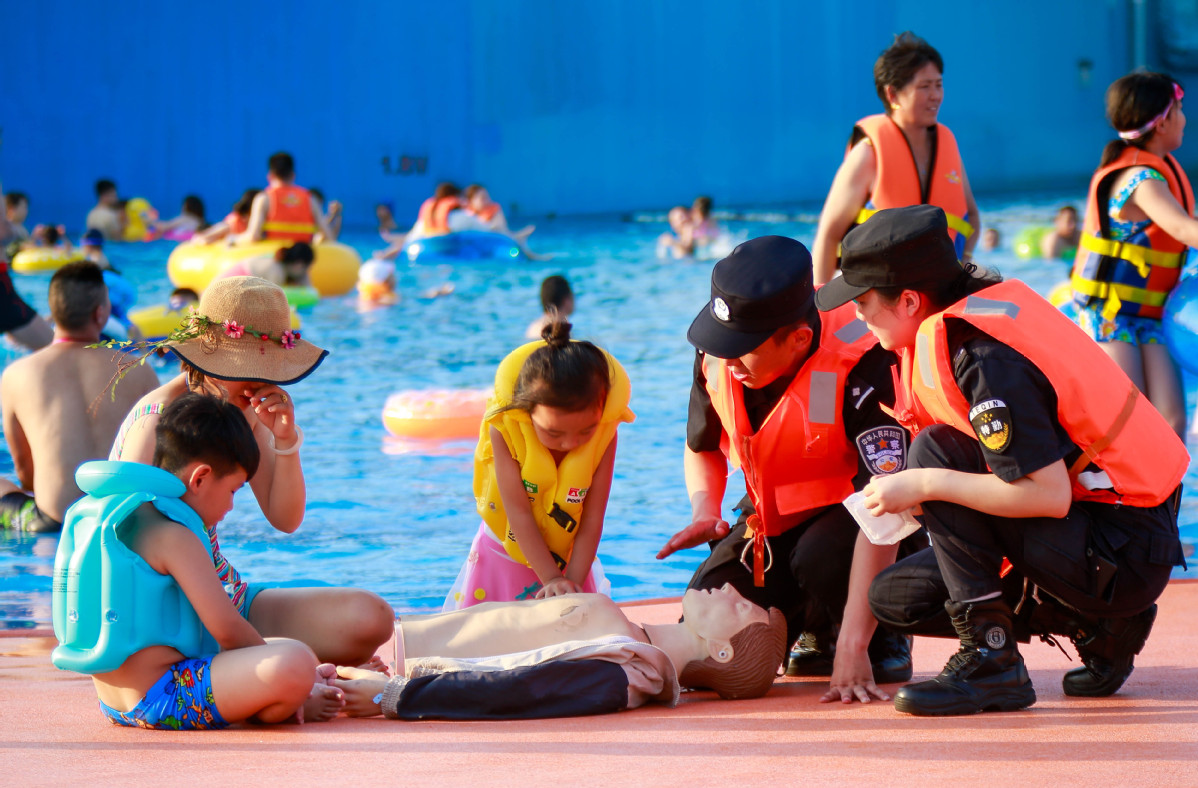Traditions and lack of educators hamper work in rural areas

Police officers teach children how to resuscitate a drowning person in Taizhou, Jiangsu province. [Photo provided to China Daily]
Child safety experts said efforts to prevent accidents and help children deal with the aftermath of incidents face many challenges in smaller cities and rural regions as a result of traditional ideas and a lack of educators in the field.
In recent years, Cui Minyan, chief representative of the China office of the NGO Safe Kids Worldwide, has led a team that travels around the country providing information about the importance of safety features, such as baby seats in cars.
She has found that the response in rural areas is very different to that in cities and towns.
"In big cities such as Shanghai and Beijing, large numbers of parents stop and listen to our open-air lectures, but audience numbers are lower in small cities and rural areas," she said.
Experts have noted that more accidents occur in rural areas than in urban spaces.
A survey of about 2,400 youngsters in Beijing age 14 and younger showed that 190 urban residents and 215 children from the capital's rural areas were involved in accidents in 2014, according to a report in the journal Occupational Health and Emergency Rescue.
The experts said parents in larger cities are usually more open minded as a result of a higher level of education and easy access to information about providing safe environments for children.
"However, in smaller places people may be influenced by peer pressure and reject suggestions that they should take precautions against safety hazards. Very often they say, 'I don't know anyone who is taking such precautions,'" said Li Hao, director of the Trauma Treatment Center at the Children's Hospital of Fudan University in Shanghai.
Residents of smaller cities and rural areas are also more likely to be influenced by traditional concepts; for example, many believe that holding a baby in their arms is safer than strapping them into baby seats, according to the experts.
Cui recalled the reaction when her team visited a hospital in a second-tier city to explain the importance of using baby seats in cars. "The parents looked at us with astonishment. The expression in their eyes was as if they were saying 'No way'," she said.
Child safety experts also encourage schools in small cities and rural areas to provide specific safety education for students rather than simply reading out bulletins on the school address system outlining the dangers of playing in or near water during hot summer weather.
Cui said schools can download and use a number of online teaching aids designed for children of different ages produced by NGOs and voluntary organizations.
For example, an online behavior-oriented educational package produced by Safe Kids Worldwide has been used by schools in Shanghai, Beijing and Shijiazhuang, Hebei province, for several years.
"Our classes are not just about giving instruction. We aim to prompt changes in behavior and the formation of new habits through learning and repeated practice," Cui said
She explained that when the NGO teaches students about road safety, the points are illustrated by the use of model cars placed in the school playground to simulate the scene when a child crosses the road.
It is important to separate the sequence of events because in real life people undertake actions step by step, she said.
"We must make children clearly understand the points at which they must look left and then look right before they start crossing. It's important for them to remember that they should only cross when they have assessed the situation on the street and made sure that drivers have seen them."
She encouraged schools and kindergartens in large cities to share their good safety practices and experience - such as how to prevent accidents in crowded corridors - with schools in rural regions.






